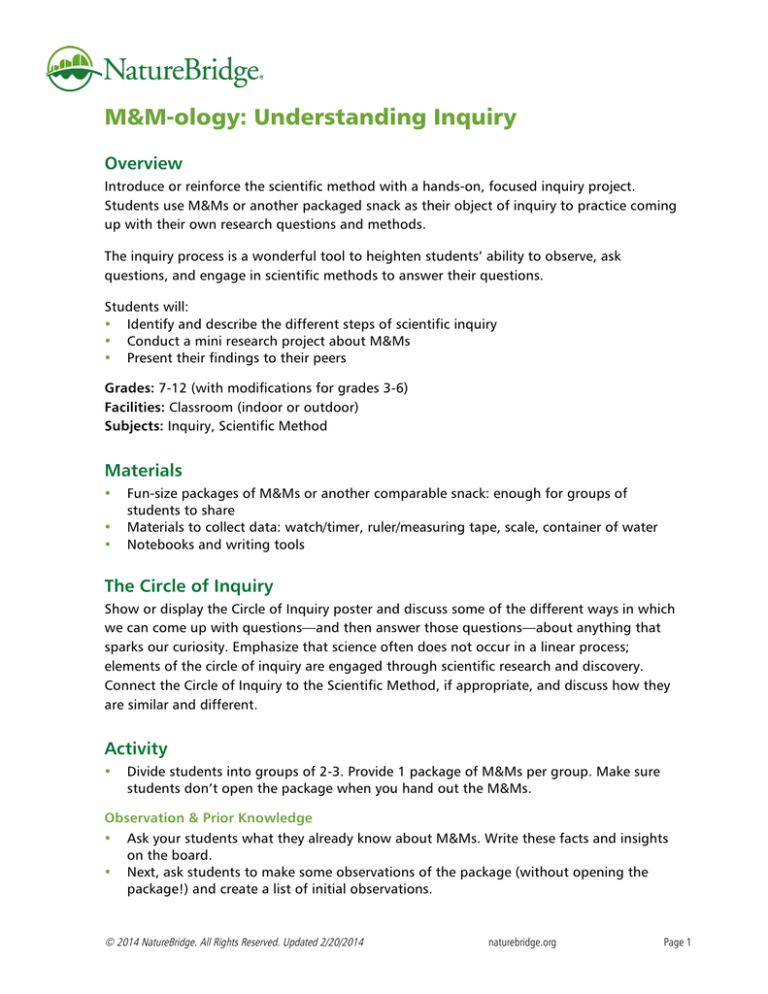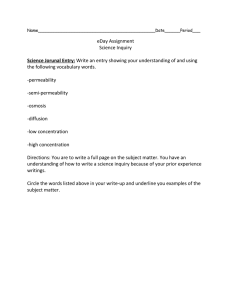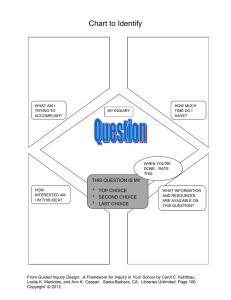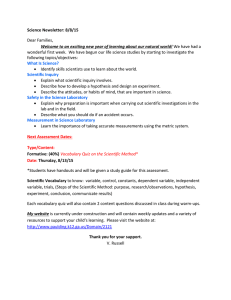
M&M-ology: Understanding Inquiry
Overview
Introduce or reinforce the scientific method with a hands-on, focused inquiry project.
Students use M&Ms or another packaged snack as their object of inquiry to practice coming
up with their own research questions and methods.
The inquiry process is a wonderful tool to heighten students’ ability to observe, ask
questions, and engage in scientific methods to answer their questions.
Students will:
• Identify and describe the different steps of scientific inquiry
• Conduct a mini research project about M&Ms
• Present their findings to their peers
Grades: 7-12 (with modifications for grades 3-6)
Facilities: Classroom (indoor or outdoor)
Subjects: Inquiry, Scientific Method
Materials
•
•
•
Fun-size packages of M&Ms or another comparable snack: enough for groups of
students to share
Materials to collect data: watch/timer, ruler/measuring tape, scale, container of water
Notebooks and writing tools
The Circle of Inquiry
Show or display the Circle of Inquiry poster and discuss some of the different ways in which
we can come up with questions—and then answer those questions—about anything that
sparks our curiosity. Emphasize that science often does not occur in a linear process;
elements of the circle of inquiry are engaged through scientific research and discovery.
Connect the Circle of Inquiry to the Scientific Method, if appropriate, and discuss how they
are similar and different.
Activity
•
Divide students into groups of 2-3. Provide 1 package of M&Ms per group. Make sure
students don’t open the package when you hand out the M&Ms.
Observation & Prior Knowledge
•
•
Ask your students what they already know about M&Ms. Write these facts and insights
on the board.
Next, ask students to make some observations of the package (without opening the
package!) and create a list of initial observations.
© 2014 NatureBridge. All Rights Reserved. Updated 2/20/2014
naturebridge.org
Page 1
Question
•
•
•
•
•
Using the lists of observations and prior knowledge, ask students what more they want
to know about their bag of M&Ms. Let students brainstorm research questions in
groups.
Research questions must be: 1) measurable, 2) testable and 3) timely (answerable in 10
minutes). Students may propose questions that are unmeasurable or untestable: create
an area on the board (“Idea Shed”) to deposit those types of questions. Discuss why
some questions make good research questions and others don’t.
Prompts for measurable research questions could include: How many? How often? How
long? Which? What? Questions that begin with “Why?” are often not measurable.
Refer to the Common Mistakes in the Scientific Process document to help guide
students to a testable research question.
Modification for grades 3-6: Guide the whole class to a single research question that is
testable through observation and counting.
Hypothesis
•
•
•
Each group should choose one research question then develop educated guesses
(hypotheses) about their research question. Each student should record his or her own
hypothesis: a group will share a research question, but group members’ hypotheses may
vary.
A simple model to use when developing a hypothesis is: I think_____ because______.
Note that this statement encourages students to ground their hypotheses in either prior
knowledge or an initial observation.
Share and discuss some of the hypotheses.
Materials and Method
•
•
•
Ask students to discuss what materials they need in order to find out the answer to
their question, as well as the steps (method) they will take to do their experiment.
Gather the appropriate materials.
Modification for grades 3-6: Focus on the method only, helping students to
understand the need to plan and articulate their research method before collecting their
data.
Data Collection
•
•
Students conduct their experiments and record their data. Remind students what
constitutes data. Are they using quantitative data?
This is another great place to refer to Common Mistakes in the Scientific Process.
Results & Analysis
•
Students determine in their small groups whether their results support their hypotheses.
Encourage students to avoid using the words “right” or “wrong” and focus instead on
proving or disproving a hypothesis and on what they learned about M&Ms.
Conclusions
•
Discuss as a group: What did students learn from this experiment? What do they think
the data means? Did they find any patterns from their data? Is there anything they are
© 2014 NatureBridge. All Rights Reserved. Updated 2/20/2014
naturebridge.org
Page 2
still wondering about? Do they have a new hypothesis or a different way to do the
experiment?
Sharing
•
Ask students to follow the steps in the circle of inquiry when they share. Encourage
students to ask inquiry-based questions of other groups following their presentations.
Discussion
Often, scientists come up with new questions and hypotheses after conducting their
original experiments, and they continue to experiment to explore these new questions. Even
if an experiment supports a hypothesis, the experiment will typically be replicated again and
again to make sure the original findings were not just by chance. This is how science
advances; it is circular, and the process never ends. Ask students how they could apply the
inquiry process of this activity to another recent activity or to a specific topic in your
subject.
Ask students how they solve problems outside of the classroom. Do they notice any
similarities or differences? Discuss how thinking like a scientist can benefit students in other
subjects and out of school.
Modification for grades 3-6: Discuss the circular nature of scientific research and how realworld scientists use the inquiry process. Ask students how they might apply the circle of
inquiry to a problem outside the classroom: select one non-academic problem and
brainstorm as a class how to solve it using scientific inquiry.
NOTE: This lesson plan adapted from an unknown source by NatureBridge environmental science educators and
curriculum experts.
Standards
Common Core State Standards
Next Generation Science Standards
Grade 3: CCSS.ELA-Literacy.RI.3.3, 3.10
Grade 4: CCSS.ELA-Literacy.RI.4.3, 4.10
Grade 5: CCSS.ELA-Literacy.RI.5.3, 5.10
Grades 6-8: CCSS.ELA-Literacy.RST.6-8.3
Grades 9-10: CCSS.ELA-Literacy.RST.9-10.3
Grades 11-12: CCSS.ELA-Literacy.RST.11-12.3
Grade 4: 4ETS1-1, 1-2
Grade 5: 5ETS1-1, 1-2
Grade 6: 6ETS1-2, 1-3, 1-4
Grade 7: 7ETS1-2, 1-3, 1-4
Grade 8: 8ETS 1-2, 1-3, 1-4
Attachments
Circle of Inquiry Poster
Common Mistakes in the Scientific Process (handout)
© 2014 NatureBridge. All Rights Reserved. Updated 2/20/2014
naturebridge.org
Page 3
Common Mistakes in the Scientific Process
Mistake
Description
Example
Faulty
questioning
Asking questions that cannot be
answered through empirical
observation or experimentation;
making assumptions within a question
Why are M&Ms round? Why do
some M&Ms taste different?
Subjective
measurements
Testing for subjective or immeasurable
factors
How crunchy is an M&M? When do
M&Ms get soft?
Emotional
attachment
Desiring a particular outcome
I think the green M&Ms will taste
different than the red ones. I took
a green one, tasted it, and it was
different than the red M&M that I
tasted.
Uncontrolled
variables
(pseudoreplication)
Having multiple uncontrolled variables
and not accounting for them during
the experiment
How long will it take an M&M to
melt in a glass of water? Potential
uncontrolled variables: water
temperature, size of glass, amount
of water, color of M&M, size of
M&M, etc.
Biased sampling
(3 types)
Mining data: Preferentially taking parts
of data to prove what you believe to
be true
One out of 6 bags of M&Ms had 4
greens, so I’ll just show that 1 on
my graph.
Unconscious observer bias:
Interpreting the results of your data
based on what you believe to be true
One out of 6 bags of M&Ms had 4
greens, so there must be
something wrong with the other
bags.
Small sample size: taking a small
sample size to highlight random
variation rather than general trends
I sampled 1 bag of M&Ms, which
had 4 greens. Therefore, all bags of
M&Ms must have 4 greens.
Coming to conclusions without
critically examining your materials,
methods, data collection, or results
with the intent of finding possible
pitfalls
I counted 4 M&Ms. Nobody else
counted, because I paid attention
when I counted.
Not
acknowledging
potential error
© 2014 NatureBridge. All Rights Reserved. Updated 2/20/2014
naturebridge.org
Page 1



